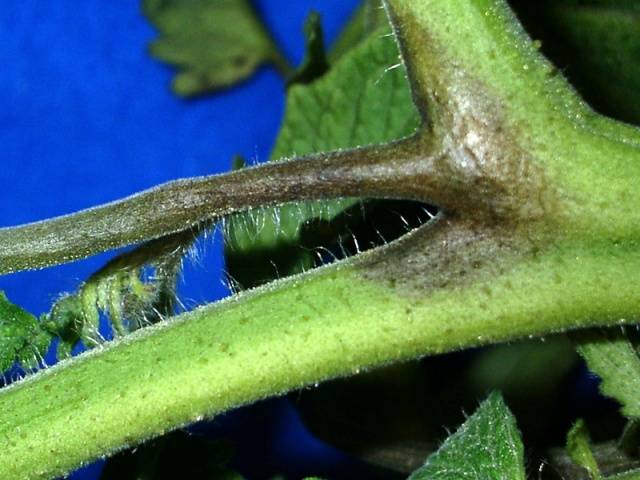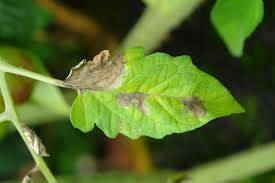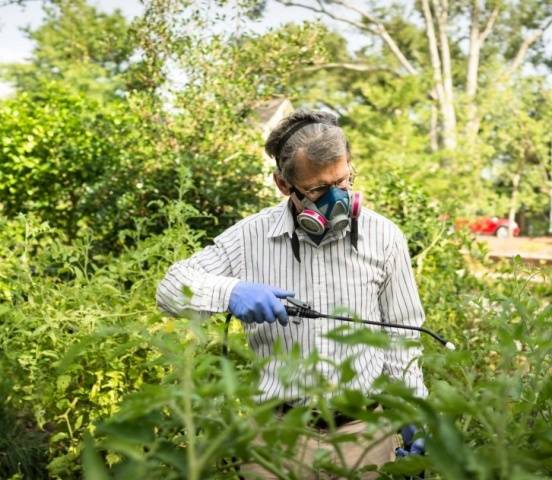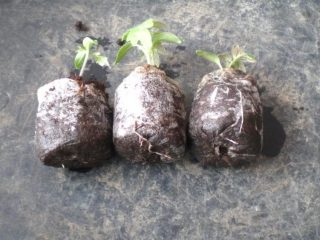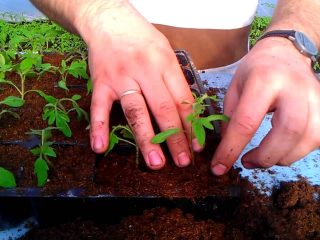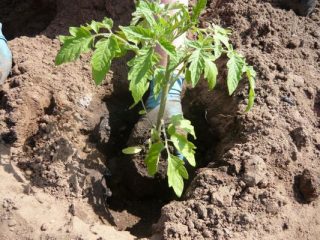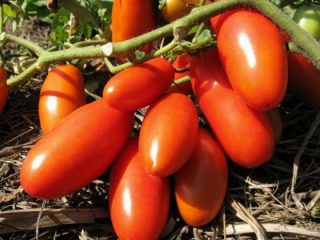Content
There is hardly a gardener who is completely unfamiliar with late blight. Unfortunately, anyone who has ever grown tomatoes knows about this disease firsthand. Late blight is very dangerous, because it appears suddenly and spreads very quickly - in a couple of days a farmer can lose all his plants if he does not take any measures.
How to protect tomatoes from late blight, what preventive measures to take, and what to do if tomatoes are already infected with fungus - all this is in this article.
What is late blight and why is it dangerous?
Late blight is a fungal disease that mainly affects plants from the nightshade group. Most often, potatoes become infected with this disease, followed by tomatoes.
Translated from Latin, late blight means “harvest devouring.” And this is true: first, the fungus appears on the underside of tomato leaves and looks like small brown spots, then the foliage turns black, dries out and falls off, then late blight spreads to the inflorescences and fruits, and lastly affects the stems of the bushes. As a result, the tomatoes simply die, and almost ripened fruits become unfit for consumption.
Today, more than a hundred species of late blight are known, any of them is very dangerous. The spores of the fungus that causes late blight are so tenacious that they can remain in any environment for up to three years:
- on tomato seeds;
- in the ground;
- in plant remains;
- on gardening tools;
- on the walls of the greenhouse.
Phytophthora loves cool weather, lack of direct sunlight, poor access to fresh air, sudden temperature changes and high humidity. To protect tomatoes from a dangerous disease, it is necessary to exclude all factors favorable for the development of late blight.
What causes late blight on tomatoes?
There are many reasons why tomatoes become infected with late blight. However, Strong and healthy plants, which are properly cared for, fed in a timely manner and properly watered, almost never get sick, including late blight.
And the peak of late blight occurs in August, when it is still very hot during the day and cool at night - as a result of which dew falls on the tomatoes.
The main task of a gardener is to prevent a combination of such factors. It is important to remember that late blight fungus will definitely appear when:
- tomatoes are planted too close to potatoes or other nightshade plants;
- last year, nightshade crops grew in a plot with tomatoes, and spores of the late blight fungus remained in the ground;
- constant high humidity remains on the site or in the greenhouse;
- air temperature is too low;
- temperature fluctuations occur, which leads to dew falling on the tomatoes, the appearance of fogs - all this contributes to an increase in humidity;
- tomatoes do not get enough sunlight because the tomatoes are planted in the shade or their plantings are too thick;
- normal air circulation between tomato bushes is disrupted;
- tomatoes were fertilized too heavily with nitrogen fertilizers;
- the soil in the tomato plot contains too much lime (acidic soils);
- knowingly infected tomato seeds or seedlings are planted.
To avoid having to bring in “heavy artillery” and use chemicals against late blight, it is necessary to provide tomatoes with competent prevention.
Prevention of late blight on tomatoes
Tomatoes are protected primarily by proper agricultural technology: compliance with planting schemes, fertilization, and watering. Agrotechnical measures directly depend on the method of growing tomatoes: in open ground or in a greenhouse, as well as on the variety and type of tomatoes: tall or determinate, early or late, resistant to fungal infections or without immunity.
So far, there are no tomatoes that are 100% free from this infection; many varieties of tomatoes have been developed with increased resistance to late blight.
The next stage in preventing tomatoes from late blight is to properly treat tomato seeds before planting as seedlings. To increase the tomato’s immunity and kill possible fungal spores on the seeds, planting material is placed in a warm solution of potassium permanganate (pale pink) for 20-30 minutes. After treatment, the tomato seeds are washed with running water and planted as usual.
Experienced gardeners also strongly recommend disinfecting the soil for seedlings and the containers themselves. Potassium permarganate is also used for these purposes.
How to protect tomatoes from late blight in open ground
The fight against late blight in garden beds involves agrotechnical measures. To prevent the fungus from having a chance, farmers do the following:
- Deoxidizes soils with a high lime content. Peat is used as a neutralizer, which is scattered over the area and dug up. This will help restore neutral acidity; late blight does not like such an environment.
- When transplanting tomato seedlings, a handful of dry sand is poured into the holes, and the tomatoes are planted in it.
- For three years, do not plant tomatoes in the place where onions, turnips, carrots, potatoes, cauliflower, cucumbers or beets previously grew - they observe crop rotation.
- For tomatoes, choose the highest place on the site; it should be well lit by the sun throughout the day and properly ventilated. If the area is low, it is recommended to do it for tomatoes raised beds.
- Tomato seedlings are planted strictly according to the scheme developed by agronomists and indicated on the bag of seeds. Under no circumstances should tomato plantings be made too thick; this will interfere with normal air circulation and shade the plants.
- Water tomatoes in the morning or late evening, when the sun's rays are no longer baking and cannot burn the leaves.Watering must be done strictly at the root of the tomato, making sure that the stems and leaves remain dry.
- If there is enough rain in the region, the tomatoes are not watered at all, so as not to increase the already high humidity.
- The soil between the tomato bushes must be loosened regularly so that the roots of the plants can also be ventilated.
- Fertilizers such as potassium and phosphorus are applied to tomatoes, which help strengthen the plant’s immunity.
- Control the amount of nitrogen fertilizers in tomatoes; there should not be too much of them.
In addition to all the safety measures listed, gardeners regularly inspect the tomatoes in the beds, turn over the leaves, and monitor the condition of the tomato stems. If late blight is detected at an early stage, there is a chance to save the crop.
It is recommended to remove tomato bushes with signs of infection along with the roots and burn them. But when most of the plants are already affected, you can try treating them with chemicals.
The gardener must remember that late blight initially affects potatoes, and then after it it attacks tomatoes. That is why these two crops are prohibited from being planted side by side.
What to do to protect tomatoes in a greenhouse
A greenhouse is an excellent habitat for any infections; late blight fungi are no exception. Fungal spores love humidity and stagnant air, and in greenhouses this is more than enough.
If the greenhouse is new, the gardener has nothing to fear - the likelihood of late blight occurring in a closed, uninfected room is extremely low.But when a greenhouse is reused, it must first be thoroughly disinfected.
Cleaning the greenhouse is as follows:
- remove cobwebs;
- wash film or glass with disinfectant;
- remove the remains of last year's plants;
- change the soil.
Agricultural technology for greenhouse tomatoes is as follows:
- Before planting, tomato seedlings are dusted with a mixture of tobacco dust and wood ash. This composition is prepared from two glasses of dust and a bucket of wood ash. When processing tomatoes, you should wear safety glasses and a mask.
- Treat the walls of the greenhouse with one of the disinfectants: Baikal, Fitosporin, Radiance or others.
- It is better to water greenhouse tomatoes using the drip method, using only warm water. Thus, moisture will flow in small doses directly under the roots of the plants.
- A greenhouse with tomatoes should be ventilated frequently by opening the windows and doors.
- There should be no condensation on the walls of the greenhouse; if moisture accumulates, wipe it with a dry cloth.
- Carry out preventive treatment of tomatoes at least three times per season.
Means to combat late blight
It is necessary to process tomatoes to prevent late blight at least three times per season. They do this according to the following schedule:
- 7-10 days after the tomato seedlings were planted in a permanent place, the tomatoes began to grow, that is, they took root in the new place.
- Just before the first flowers appear.
- Before the formation of tomato ovaries.
This schedule is only suitable for preventive treatments; if the tomatoes are still infected with late blight, the treatment must be carried out in accordance with the instructions of the selected drug.
Phytophthora can be combated using both commercial chemicals and folk remedies. Moreover, the former are more effective, but the latter will not harm either the plant itself or humans, since they are non-toxic and do not accumulate in tomato fruits.
It is necessary to treat late blight of tomatoes with fungicides - drugs that fight fungi. Gardeners most often use the following means:
- Fundazol;
- Quadris;
- Trichopolum;
- Fitosporin;
- Previkur;
- Horus;
- Thiovit.
In addition to special, narrowly targeted means, late blight is combated with Bordeaux mixture, copper oxychloride, and copper sulfate. All substances are diluted with water in accordance with the manufacturer's instructions. Usually, Fungicidal preparations are applied to tomatoes by spraying, irrigating the tomato bushes with the mixture.
Today there are a lot of antifungal medicines for tomatoes, but the active ingredient in them is usually the same. Because of this the tomato quickly becomes accustomed to the drug; if it is not possible to overcome late blight in tomatoes in one or two times, you will have to resort to folk remedies - chemistry is no longer effective.
Traditional methods
Folk remedies are used more often because they are harmless, cheap and give good results.
There are many folk ways to combat late blight in tomatoes; the most popular among the population are the following:
- Fermented whey. Whey can be purchased at the store or prepared independently using kefir. To prepare medicine for tomatoes, the serum must be diluted with water in a 1:1 ratio. Starting from the first days of July, you can spray tomato bushes at least daily (depending on the condition of the plants).
- Garlic tincture is also a strong remedy against late blight in tomatoes. To prepare the composition, take not only garlic cloves, but also greens, arrows, and any part of the plant. All this is thoroughly crushed (you can twist it in a meat grinder), poured with water and left for a day. After 24 hours, drain the liquid, filter and dilute with clean water. For greater effect, you can add potassium permanganate (about 1 gram) to the same composition. Tomato bushes are irrigated with the solution.
- Wood ash It is good to use as a primary treatment of tomatoes - 10 days after planting seedlings in the ground. The ground between the tomatoes is sprinkled with a thin layer of ash and watered with warm water. The treatment can be repeated during the tomato flowering period.
- Rotten hay or straw are also a good remedy for late blight in tomatoes. The tincture is prepared as follows: a kilogram of hay is poured into a bucket of water (10 liters), a little urea is added there, and the liquid is left to infuse for 3-4 days. Then the solution is filtered and the tomato bushes are treated with it at intervals of two weeks.
- Iodine You can also treat tomatoes, because it is known as a strong antiseptic. To prepare the solution, take a bucket of water, a liter of fresh but low-fat cow's milk and 15-20 drops of iodine.The fresh composition should be sprayed onto the tomato bushes, and the treatment should be repeated every two weeks.
The salt film on the tomatoes will prevent the development of fungus, and the tomatoes will be able to ripen normally.
Results
Fighting tomato late blight is much more difficult than preventing this disease. Therefore, all the efforts of the farmer should be directed to preventive measures - prevention of tomato infection. To protect tomatoes, it is necessary to follow the agricultural practices of the crop and try to identify bushes infected with late blight at the earliest stage.
For effective control, the gardener must use combined means: alternating chemicals with traditional antifungal compounds. Irrigating tomato bushes too often is not recommended, as this can increase the humidity and further aggravate the disease. The ideal interval for treating tomatoes against late blight is 10-14 days.



